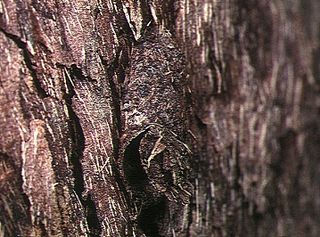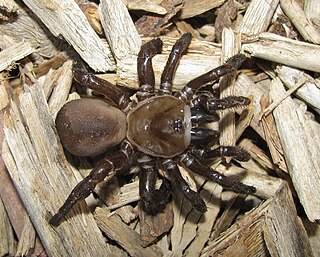
The Mesothelae are a suborder of spiders. As of April 2024, two extant families were accepted by the World Spider Catalog, Liphistiidae and Heptathelidae. Alternatively, the Heptathelidae can be treated as a subfamily of a more broadly circumscribed Liphistiidae. There are also a number of extinct families.

The spider family Liphistiidae was first recognized by Tamerlan Thorell in 1869. When narrowly circumscribed, it comprises a single genus Liphistius, native to Southeast Asia; as of April 2024, this was the circumscription accepted by the World Spider Catalog. The family contains the most basal living spiders, belonging to the suborder Mesothelae. The family has also been circumscribed more broadly to include the family Heptathelidae as a subfamily, Heptathelinae, with the narrowly circumscribed Liphistiidae becoming the subfamily Liphistiinae.

Ctenizidae is a small family of mygalomorph spiders that construct burrows with a cork-like trapdoor made of soil, vegetation, and silk. They may be called trapdoor spiders, as are other, similar species, such as those of the families Liphistiidae, Barychelidae, and Cyrtaucheniidae, and some species in the Idiopidae and Nemesiidae. The name comes from the distinctive behavior of the spiders to construct trapdoors, and ambush prey from beneath them.

The family Cyrtaucheniidae, known as wafer-lid trapdoor spiders, are a widespread family of Mygalomorphae spiders.

Lycosa is a genus of wolf spiders distributed throughout most of the world. Sometimes called the "true tarantula", though not closely related to the spiders most commonly called tarantulas today, Lycosa spp. can be distinguished from common wolf spiders by their relatively large size. This genus includes the European Lycosa tarantula, which was once associated with tarantism, a dubious affliction whose symptoms included shaking, cold sweats, and a high fever, asserted to be curable only by the traditional tarantella dance. No scientific substantiation of that myth is known; the venom of Lycosa spiders is generally not harmful.

Macrothele is a genus of mygalomorph spiders in the family Macrothelidae, and was first described by A. Ausserer in 1871. Most of the species in the genus occur in Asia, from India to Japan, and Java, with five found in Africa, and two in Europe. The name is derived from Ancient Greek μακρός ("makro-"), meaning "big", and θηλή ("thele"), referring to the spinnerets.

Cyclocosmia is a genus of mygalomorph trapdoor spiders in the family Halonoproctidae, first described by Anton Ausserer in 1871. Originally placed with the Ctenizidae, when the family split in 2018, this genus was placed with the Halonoproctidae as the type genus. The name is derived from the Greek "kyklos" (κυκλος), meaning "circle", and "kosmeo" (κοσμεω), meaning "to adorn".

Chilobrachys is a genus of Asian tarantulas that was first described by Ferdinand Anton Franz Karsch in 1892. They are found in India, Myanmar, Malaysia, China, Vietnam, Thailand and Sri Lanka. They are usually medium or large-sized, and they can stridulate by using small spines present on the chelicerae.

Phlogiellus is a genus of tarantulas that was first described by Reginald Innes Pocock in 1897. They are found throughout Asia and Papua New Guinea, including Indonesia, the Philippines, Papua New Guinea, China, Myanmar, Malaysia, Borneo, Thailand, the Solomon Islands and Taiwan. Phlogiellus is part Latin and part Greek, the first part being "φλóξ φλoγóϛ", meaning flame, the second part being "ellus" which is a latin diminutive suffix.

Conothele is a genus of mygalomorph spiders in the family Halonoproctidae, first described by Tamerlan Thorell in 1878. Originally placed with the Ctenizidae, it was moved to the Halonoproctidae in 2018.

Qiongthela is a genus of spiders in the family Heptathelidae. As of 2021, it contains 14 species.
Sinopesa is a genus of spiders in the family Nemesiidae. It is found in China and on Ryukyu Islands in Japan. It was first described in 1995 by Raven & Schwendinger. As of 2023, it contains 8 Asian species.

Halonoproctidae is a family of mygalomorph spiders, split off from the family Ctenizidae in 2018. Species in the family are widely distributed in North and Central America, Australasia, Asia, southern Europe and North Africa. One species is recorded from Venezuela in South America. They are relatively large, sombrely coloured spiders, that live in burrows with some kind of trapdoor.

Avicularioidea is a clade of mygalomorph spiders, one of the two main clades into which mygalomorphs are divided. It has been treated at the rank of superfamily.

Cyclocosmia ricketti, commonly known as the Chinese hourglass spider, is a species of trapdoor spider of the genus Cyclocosmia, which refers specifically to mygalomorphus animals. Cyclocosmia ricketti is native to China and it was first described in 1901 by Mary Agard Pocock. They are characterized by their truncated abdomen and the rigid disk at the bottom with a pattern.














